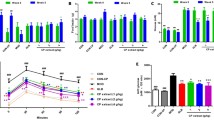Abstract
The aim of this study was to determine whether Caulerpa lentillifea extract (CLE) can protect pancreatic beta cells and enhance insulin signaling in adipocytes. We measured the protein tyrosine phosphatase (PTP)-1B inhibitory effect of CLE using an in-vitro enzyme assay. Proteins involved in the pancreatic beta-cell death and insulin signaling were measured by western blotting. Oil-red O staining was used to measure the insulin mimetic effect of CLE. CLE strongly inhibited the PTP1B enzyme. In rat insulinoma (RIN)-m5F cells, CLE decreased the activation of extracellular regulated kinase (ERK)-1/2, P38 mitogen activated protein kinase (P38), c-Jun NH2-terminal kinase (JNK), and nuclear factor kappa-light-chain-enhancer of the activated B cells (NF-κB). Furthermore, CLE showed insulin-mimetic effect and enhanced the activation of insulin-signaling molecules including IRS, AKT, PI3K, and GSK-3β in 3T3-L1 adipocytes. Our results suggested that CLE-inhibited PTP1B, protected the pancreatic beta cells, and enhanced insulin sensitization in the adipocytes.
Similar content being viewed by others
References
American Diabetes Association. Diagnosis and classification of diabetes mellitus. Diabetes Care 33: S62–S69 (2010)
Kahn SE. The relative contributions of insulin resistance and beta cell dysfunction to the pathophysiology of type 2 diabetes. Diabetologia 46: 3–19 (2003)
Csorba TR, Lyon AW, Hollenberg MD. Autoimmunity and the pathogenesis of type 1 diabetes. CRC Cr. Rev. Cl. Lab. Sc. 47: 51–71 (2010)
Cerf ME. Beta cell dysfunction and insulin resistance. Front. Endocrinol. 4: 37 (2013)
Ruiz RF, Vieira E, Garcia-Roves PM, Gomis R. Protein tyrosin phosphatase 1B modulates pancreatic beta cell mass. PLoS ONE 9: e90344 (2014)
Johnson TO, Ernolieff J, Jirousek MR. Protein tyrosin phosphatase 1B inhibitors for diabetes. Nat. Rev. Drug Discov. 1: 696–709 (2002)
Cragg GM, Newman DJ. Natural products: A continuing source of novel drug leads. Biochim. Biophys. Acta 1830: 3670–3695 (2013)
Sharma BR, Rhyu DY. Anti-diabetic effects of Caulerpa lentillifera: Stimulation of insulin secretion in pancreatic beta cells and enhancement of glucose uptake in adipocytes. Asian Pac. J. Trop. Biomed. 4: 575–580 (2014)
Sharma BR. Kim HJ, Rhyu DY. Caulerpa lentillifera extract ameliorates insulin resistance and regulates glucose metabolism in C57BL/KsJ-db/db mice via PI3K/AKT signaling pathway in myocytes. J. Transl. Med. 13: 62 (2015)
Sharma BR, Kim MS, Rhyu DY. Nelumbo nucifera leaf extract attenuated pancreatic beta cells toxicity induced by interleukin-1ß and interferon-?, and increased insulin secretion of pancreatic beta cells in sterptozotocin-induced diabetic rats. J. Tradit. Chin. Med. 36: 71–77 (2016)
Park CH, Rhyu DY, Sharma BR, Yokazawa T. Inhibition of preadipocyte differentiation and lipid accumulation by 7-O-galloyl-D-sedoheptulose treatment in 3T3-L1 adipocytes. Biomed. Prev. Nutr. 3: 319–324 (2013)
Gum RJ, Gaede LL, Koterski SL, Heindel M, Clampit JE, Zinker BA, Trevillyan JM, Ulrich RG, Jirousek MR, Rondinone CM. Reduction of protein tyrosin phosphatase 1B increases insulin dependent signaling in ob/ob mice. Diabetes 52: 21–28 (2003)
Davis JA, Sharma S, Mittra S, Sujatha S, Kanaujia A, Shukla G, Katiyar C, Lakshmi BS, Bansa VS, Bhatnagar PK. Antihyperglycemic effect of Annona Squamosa hexane extract in type 2 diabetes animal model: Ptp1B inhibition, a possible mechanism of action? Indian J. Pharmacol. 44: 326–332 (2012)
Pirot P, Cardozo AK, Eizirik DL. Mediators and mechanisms of pancreatic beta cell death in type 1 diabetes. Arq. Bras. Endocrinol. Metab. 52: 156–165 (2008)
AbouZid SF, Ahmed OM, Ahmed RR, Mahmoud A, Addella E, Ashour MB. Antihyperglycemic effect of crude extracts of some Egyptian plants and algae. J. Med. Food 17: 400–406 (2014).
Mackenzie RW, Elliott BT. Akt/PKB activation and insulin signaling: A novel insulin-signaling pathway in the treatment of type 2 diabetes. Diabetes Metab. Syndr. Obes. 7: 55–64 (2014)
Author information
Authors and Affiliations
Corresponding author
Rights and permissions
About this article
Cite this article
Sharma, B.R., Kim, H.J. & Rhyu, D.Y. Caulerpa lentillifera inhibits protein-tyrosine phosphatase 1B and protects pancreatic beta cell via its insulin mimetic effect. Food Sci Biotechnol 26, 495–499 (2017). https://doi.org/10.1007/s10068-017-0068-4
Received:
Revised:
Accepted:
Published:
Issue Date:
DOI: https://doi.org/10.1007/s10068-017-0068-4




